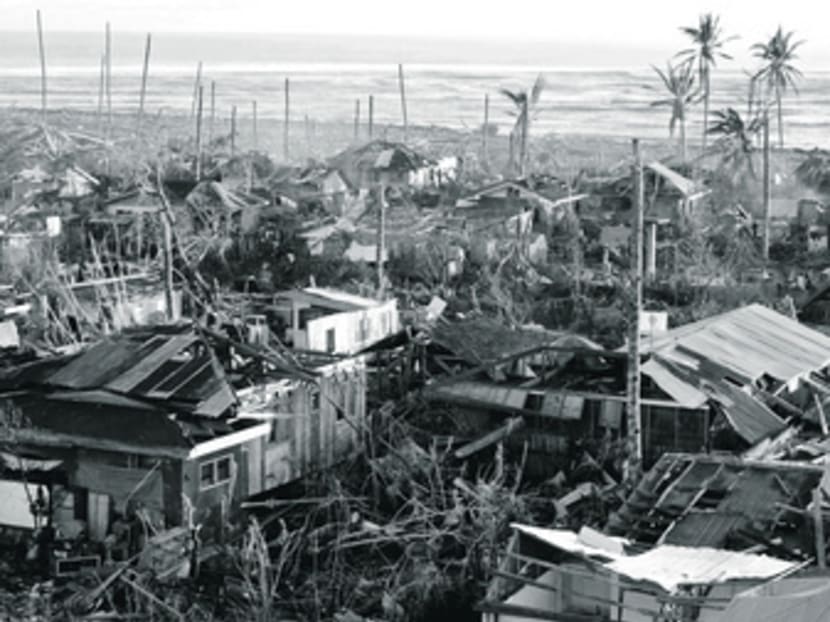South-east Asia pays price for climate inaction
Last week, Mr Naderev Sano, the Philippines’ chief negotiator at the Doha climate change talks, broke down in tears. While delegates from around the world were earnestly debating their non-response to climate change, his homeland was being lashed by a real-life typhoon.

The coastal town of Cateel in the Philippines was left in tatters after being struck by Typhoon Bopha last Tuesday. REUTERS
Last week, Mr Naderev Sano, the Philippines’ chief negotiator at the Doha climate change talks, broke down in tears. While delegates from around the world were earnestly debating their non-response to climate change, his homeland was being lashed by a real-life typhoon.
Mr Sano had no hesitation in linking the catastrophe to global warming. “I appeal to leaders from all over the world to open our eyes to the stark reality that we face,” he said.
Typhoon Bopha was classified as a Category 5 super typhoon. That means it was really big. It killed more than 700 people as it tore through the southern island of Mindanao at speeds of 257kph. More than 800 people are still missing.
Assuming none are found, in human casualty terms, Bopha would be more than five times as catastrophic as Hurricane Sandy, which had grabbed people’s attention in October as it battered the United States’ eastern seaboard.
Although the Philippine authorities knew for days that Bopha would make landfall, they could not have known where it was going to hit. Normally, typhoons do not travel so far south towards the equator.
“With climate change, it’s hard to figure out which regions are typhoon-prone,” Mr Cesar Purisima, the Philippine’s Finance Secretary, told me in Manila.
Mr Albert del Rosario, the Foreign Secretary, said his country was among the most vulnerable in the world to climate change.
ALARMING PATTERNS
It is next to impossible to pin a specific weather event on the broader effects of climate change. Professor Jean-Pascal van Ypersele, Vice-Chairman of the Intergovernmental Panel on Climate Change, did seek to make the link with Hurricane Sandy, saying it was less likely to be a “coincidence” than an auger of more extreme weather events to come.
For the most part, we are stuck looking at long-range patterns. In the case of the Philippines, those patterns look alarming. The number of floods and severe storms to affect the archipelago has risen more than five-fold since the 1960s.
South-east Asia, it turns out, is one of the world’s most vulnerable regions. Home to nearly 600 million people, it has long coastlines, high population densities in coastal areas and a strong reliance on agriculture for livelihoods.
Mindanao is predominantly rural. However, an even bigger risk to South-east Asia — and beyond it to Asia as a whole — are the crowded cities at high risk of inundation.
In 2007, the Organisation of Economic Co-operation and Development put out a study of megacities at risk from floods and super storms. No fewer than 15 of the top 20 were in Asia, with all top eight in the region. They were Mumbai, Dhaka, Ho Chi Minh City, Guangzhou, Shanghai, Bangkok and Yangon. Manila, much of which was under water in August, didn’t even make the list.
Business is vulnerable. In recent decades, there has been a shift of manufacturing to Asia. South-east Asia is a vital part of a supply chain often associated with “Made in China”. When floods hit Thailand last year, computer and car production elsewhere ground to a halt. The Thai floods ended up being one of the five costliest natural disasters to insurers in the past three decades.
Prof Niall Ferguson, the Harvard historian, predicts a recovery in US manufacturing. He cites the discovery of abundant cheap energy sources in the US but also industry fears of Asian supply-chain disruption as a result of volatile weather.
“North America will fare better than East Asia,” he writes. “Natural disasters will happen, of course, as Hurricane Sandy reminded us. But there will be more on the other side of the Pacific.”
ADAPT TO THE INEVITABLE
Mr Sano’s tears stemmed partly from the realisation that humans are most unlikely to act quickly enough to reverse the trend.
South-east Asia itself accounts for 12 per cent of CO2 emissions so it could make, at best, a marginal difference if it could halt deforestation and switch to less polluting forms of energy generation. Either way, Bopha will not be the last devastating tropical storm to hit the Philippines.
That leaves adaptation to what looks more and more like the inevitable. The Philippines is seeking to improve disaster preparedness and early warning systems. It is producing maps of at-risk areas and introducing a logging ban that it will struggle to enforce. It is also seeking to clamp down on illegal mining, which can exacerbate the risk of landslides.
It is not a lot. But with limited resources and an international community that prefers talk over action, it’s all there is.
The Financial Times Limited
David Pilling
David Pilling is the Financial Times’ Asia editor.






